June 16, 2022 – The Old Church into the New School Library and Main Office
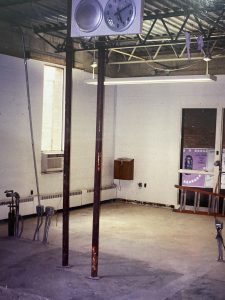
The plans for renovation meant there would be so much more space available! The confessionals were renovated into the new entrance to the school office.
A new Building Committee was formed whose members were: Father Len Sudlik, Paul Glovick, Sharon Grant, Mary LaPonsie, Don McWatters, Daryl Nowicki, Karen Oshinski, Rochard Polanic, Charles Przekop, Bill Terpstra and Chuck Wieten.
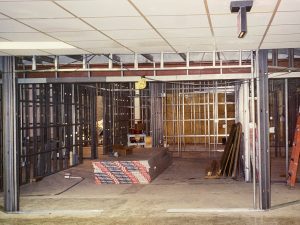 New space was now available for parish education, including new administrative offices. There was room for a library, computer room, counseling rooms, a new and expanded teacher’s lounge, expanded Religious Education offices, and more. The entire parish was to benefit.
New space was now available for parish education, including new administrative offices. There was room for a library, computer room, counseling rooms, a new and expanded teacher’s lounge, expanded Religious Education offices, and more. The entire parish was to benefit.
April 7, 2022 – Art & Environment Committee for the New Church (1990s)
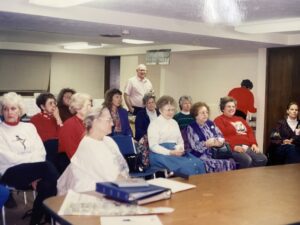
The Art & Environment Committee put great research, time, effort, and intention in their dedicated work of designing the interior and exterior of the new church built in the early 90s. The names listed below are all of those included in the Art & Environment binder stored in the parish office- those listed as members as well as those who signed in at the building meetings.
Co-Chairpersons:
Margo DeWitt and Chris Donley
| Ann Baker | Amy Kirchhoff | Diane Rider |
| Sr. Myra Bergman | Audrey Kluting | Abe Rossi |
| Chris Buczek | Vivian Kommer | Carl & Ellie Rossi |
| Peggy Dalrymple | Judy Maggini | Laurie Schaut |
| Marcia Dohm | Josephine Mancewicz | Pat Schaut |
| Jane Doyle | Marilyn Mancewicz | Suzanne Schmieder |
| Katie Eberhard | Richard Michalski | Paula Strockis |
| Jim & Lois Flickinger | Tess Milanowski | Diane Valliere |
| Sandy Gill | Lisa Nawrocki | Betty VanderLaan |
| Maureen Grey | Harriet Pilson | Maggie Wind |
| Ruth Jubb | Richard Polanic | Henry Zeman |
| Janet Kenny | Marge & Ron Prominski |
March 24, 2022 – The Carvings in the Altar
In regards to the altar, Fr. Tom Johnson explained:
“Liturgical reform focuses on the Eucharist. The altar represents three things; a table (i.e. meal, community, gather around), the cross (a place of sacrifice) and the cold, empty tomb. The altar can take on a variety of shapes. It must be sufficient in size for one person to stand by, and enough room to hold the Book, Chalice (decanter) and Bread. Relics are no longer necessary in the altar.”
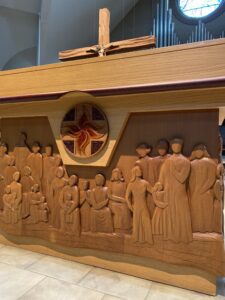 Taking all of that information into consideration, the Art & Environment Committee- along with Bill Cox (the head architect)- were very intent on the altar carvings portraying the many persons involved in the parish. With that concept as the forethought of the altar carving design,
Taking all of that information into consideration, the Art & Environment Committee- along with Bill Cox (the head architect)- were very intent on the altar carvings portraying the many persons involved in the parish. With that concept as the forethought of the altar carving design,
Bill brought in Mary Witte from Designers Workshop or DW2 Inc. She gave a presentation in regards to her work and commented that after seeing the drawings,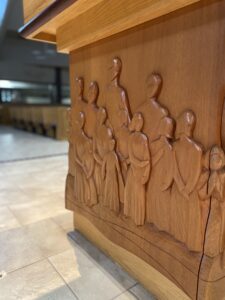 the budget outlined for the project of liturgical appointments was reasonable. Mary was responsible for the millwork, furnishing, and carvings of the altar, the presider chair, the acolyte seating, the credence table, the holy water fonts, and the ambo and lectern. She would combine her professionalism as well as her sensitivity to the project. She estimated the total project would take 3-4 months.
the budget outlined for the project of liturgical appointments was reasonable. Mary was responsible for the millwork, furnishing, and carvings of the altar, the presider chair, the acolyte seating, the credence table, the holy water fonts, and the ambo and lectern. She would combine her professionalism as well as her sensitivity to the project. She estimated the total project would take 3-4 months.
Together between Mary Witte, Bill Cox, and the committee, the altar carvings were designed to depict a “story to be told” by way of figures (adults and children alike) demonstrating teaching, listening, making gestures of care and kindness towards each other, and sharing in the life that makes up our community.
Excerpts taken from the Art & Environment Committee’s Meeting Minutes 1992-1994.
They desired for each person to come to the altar to find themselves in the story of salvation and the Christian life. So the next time you come to worship in this holy and beautiful church, where do you see yourself in the altar?
March 10, 2022 – Stations of the Cross
Ed Graverson, a woodcarver, was considered for the Stations and other wood work and made a presentation to the Art & Environment Committee at the beginning of 1994. He gave background information and showed some stations that he had carved for Our Lady of Sorrows Church. He preferred to do carvings from furnished drawings. At the same meeting, Judy Maggini shared that she would like to be considered to do the drawings for the stations.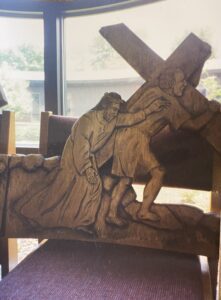
In February of 1994, “A motion was made… to have Judy Maggini do the design and drawings on her time schedule. A friendly amendment was made… to have Ed Graverson, woodcarver, and Judy work together on the stations….with the corpus being in a bronze tone it would be good to include some bronze accents in the stations.”
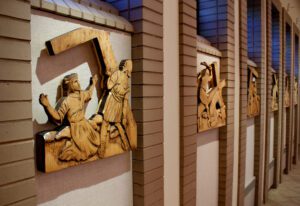 Judy asked the committee at subsequent meetings for consensus of style for the Stations of the Cross. The committee leaned toward a more full figure style in a raised relief. Judy desired to have the committee’s approval on each drawing before it was submitted to Ed Graverson for carving, the first drawing was approved. She then presented station drawings for #2,3 and 4. There was a question as to where the Roman numerals should go – either on the carving or be separate. Another question arose as to whether the background should be of solid wood or the figures should be cut out with no solid background. It was the architect’s feeling to go with a cut-out style.
Judy asked the committee at subsequent meetings for consensus of style for the Stations of the Cross. The committee leaned toward a more full figure style in a raised relief. Judy desired to have the committee’s approval on each drawing before it was submitted to Ed Graverson for carving, the first drawing was approved. She then presented station drawings for #2,3 and 4. There was a question as to where the Roman numerals should go – either on the carving or be separate. Another question arose as to whether the background should be of solid wood or the figures should be cut out with no solid background. It was the architect’s feeling to go with a cut-out style.
In July of 1994, Station drawings were presented by Judy for all 14 stations, and the drawings were accepted as presented. They were beautiful! At that point, the drawings were handed on to Ed Graverson to be carved! And the stations that surround you when you come to Mass are those very carvings created by Ed Graverson from the vision of Judy Maggini. Join us for the Stations of the Cross every Friday this Lent at 7:00 pm to look at them with a new lens now that you know some of the history behind them!
Excerpts taken from the Art & Environment Committee’s Meeting Minutes 1992-1994.
March 3, 2022 – Priests Who Have Served at Holy Spirit Parish
| 1952-1976 | Rev. Bernard Sikorski (Founding Pastor) | 1980-1984 | Rev. Charles Spliedt |
| 1956-1957 | Rev. Julian Korsakas | 1982-1984 | Rev. Dennis O’Donnell |
| 1957-1958 | Rev. James Morley | 1984-1987 | Rev. Wayne Wheeler |
| 1958-1959 | Rev. John Sullivan | 1984-1985 | Rev. Steve Dudek |
| 1959-1960 | Rev. Leo Zielinski | 1985-1986 | Rev. Dan De Pew |
| 1960-1965 | Rev. John Tupper | 1987-1990 | Rev. John Valliere |
| 1965-1970 | Rev. Leonard Gross | 1990-1992 | Rev. Dan Cook |
| 1970-1972 | Rev. Melvin Fox | 1992-1995 | Rev. Mark Przybysz |
| 1973 | Rev. Patrick Gauchet | 1995-2005 | Rev. Leonard Sudlik |
| 1973 | Rev. Kenneth Schichtel | 1996-1997 | Rev. Charles Brown |
| 1973 | Rev. Tom Simons | 1997-1998 | Rev. Ron Hutchinson |
| 1975-1976 | Rev. Fred Brucker | 2005-2018 | Rev. John Valliere |
| 1976-1984 | Rev. Anthony Vainavicz | 2005-2007 | Rev. Peter Schafer |
| 1976 | Rev. Richard Van Lente | 2007-2008 | Rev. Matthew Barnum |
| 1976-1984 | Msgr. Edmund Falicki (Retired, in residence) | 2015-2016 | Rev. James VanderLaan |
| 1979-1980 | Rev. Rock Badgerow | 2018- present | Rev. Mark Peacock |
February 24, 2022 – The Stationary Cross and Processional Crucifix
A priest from the Diocesan Office of Worship was a guest at one of the early subcommittees meeting and shared current liturgical philosophies and guidelines. In terms of concepts related to the Crucifix; ‘The crucifix does not have to be on a wall. The guidelines state there is to be only one cross. Duplication of symbols should not occur.” Concern was raised about having a corpus available all the time for people to have the opportunity to meditate upon….suggestion to have the crucifix present in the cross except at time of procession.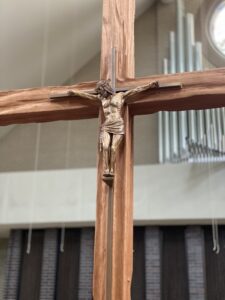
Much discussion was held in regards to various items such as wood vs. fiberglass, bronze, the weight of the processional cross to be carried, the idea of a contrast between the corpus and the large cross, material to be used in the large cross, and so on.
A subcommittee was created, headed by Judy Maggini, to work on the design of the crucifix and the corpus in regards to what would be the most liturgically appropriate. As a result, Judy made a presentation of a drawing of a corpus that she did from a picture in a catalog that was decided upon at their meeting. A motion was made to accept these conceptual drawings with refinements and passed unanimously. Jim Wisnewski (father of Lisa Nawrocki) was chosen to do the Corpus in fiberglass to look like bronze.
As for the fixed cross, the decision seemed to be between a simple oak wood and redwood. A motion was made to use the redwood for the fixed cross, and that passed unanimously as well. Jim Wisnewski showed further developments of the corpus. After comments and discussion it was decided that Judy Maggini would see the final sculpture for approval before Jim would start the molding process. The committee was very pleased with the final look of the cross and crucifix once they were placed in the church.
Excerpts taken from the Art & Environment Committee’s Meeting Minutes 1992-1994.
February 10, 2022 – Fire of 1958
The home on top of the hill, east of the church building was to be sold, and the parish purchased it to use for the Felician Sisters who were coming to teach at the school the following year. It eventually would serve as the rectory once the convent was built. By 1954, the parish had grown to 399 families and by 1956, the school was already overcrowded. In only four years, Holy Spirit had outgrown both church and school! A fund drive was initiated and completed, and construction of the new facility began on September 19, 1957.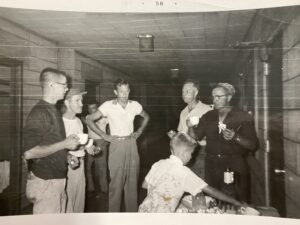
The following year, 1958, [was] most memorable because of “the fire.” Determined as an act of arson, the fire broke out in the church section of the building on August 17, 1958. Drawn by the sirens, many parishioners gathered at the site of the burning church to help the firefighters with the hoses.
Evidence showed that the fire was set in three locations in the building, with the primary blaze set behind the organ. Newspapers reported that it took over an hour to get the blaze under control, and the Walker Township firemen believed the fire to have been burning for at least two hours before the alarm sounded at 9:29 pm. Officers believed the fire may have been started by children, and that theory advanced after they learned that youngsters in the neighborhood often played in the new addition that was under construction.
Anything that could be salvaged was cleaned and saved. Jack Billin remembers hours spent with Don Stachowiak, Joe Cichon, Carl Rossi, Don Morgan, and Walt Wysocki, cleaning cement blocks so they could be re-used, mixing mortar, sodding banks, and even enlisting the 8th grade boys to provide the muscle for moving church benches. Everyone helped in any way they could. Since the new church/auditorium was near completion, men and women would arrive on Friday evenings or Saturday mornings to clean the construction area and set up over 250 chairs that were loaned to [Holy Spirit] from Shamut Hills School. The first Mass was celebrated on August 24, 1958 in a building still under construction. The old, fire damaged church was cleaned so that it could be reconstructed and used for classrooms. This project was completed on February 2, 1959. The formal dedication of the new church/auditorium building was held on September 27, 1959 with Bishop Allen Babcock presiding. So ended the second phase of building at Holy Spirit. A worship space was in use!
Excerpts taken from the Parish of the Holy Spirit 50th Anniversary Booklet.
February 3, 2022 – Stained Glass Design and Rose Window
From the beginning, “All seemed to be in favor of using ‘stained glass’ or ‘art glass’ of some nature…Another request [was] to use as much natural light as possible – bring the beauty of nature God has created for us.”
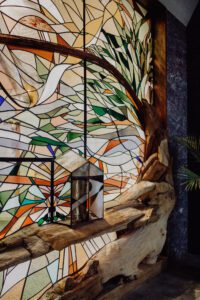
Pristine Glass was the company chosen for the stained glass project. “They appreciated being considered as they are part of our local community; they would use antique glass; their process would be to send preliminary drawings, then final drawings with glass and color samples. They also know of a company from Grand Haven that they have worked with who specializes in wood carving who looked at the project in regards to the Tabernacle table. Their (Pristine and Grand Haven) total cost of the stained glass project with the wood work for the Tabernacle would be $27,920.00 + $2100 (installation) = $30,020.”
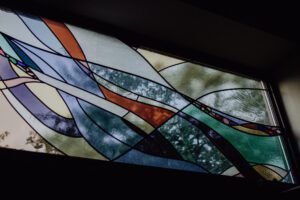
The committee, as well as the lead architect, Bill Cox, desired “to have…a concept of the station windows [drawn] depicting the wind
and adding earthly elements.”
Pristine Glass presented “drawings and glass selection for the stained glass in the Tabernacle, the station windows, and the Rose window. They followed the spirit and intentions of the conceptual drawings of Bill Cox, combining to make them buildable and representable plus breathe their own talents to form a unique presence. They showed the flow from the Tabernacle to the station windows to the Rose and from Mary to the station windows to the Rose as depicting Humanity → Divinity ← Mary.
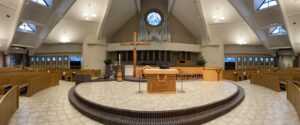
“Comment on defining the dove more in the rose window– this could be done by making the lead cane thicker than in the rest of the window. The would also be laminating and fusing glass pieces to create shadow lines and depth. Some thought the right wing in the dove appeared to be “broken.” John Rotonda explained this as symbolism indicating an “outpouring of the Spirit as spoken of in Genesis.” He also pointed out that he hoped the people of the church would discover interesting points in their own “spirits.”
Excerpts taken from the Art & Environment Committee’s Meeting Minutes 1992-1994.
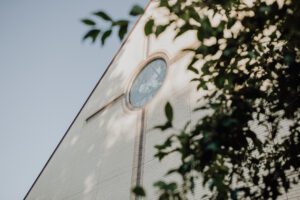
Amazing! Have you ever noticed some of these details in the stained glass, between the Tabernacle, the Rose window, and the windows above the stations of the cross? Next time you are in the sanctuary, take time to notice the intentionality in which the Art & Environment Committee designed each aspect of the glass. Reflect on the dove; where have you seen the Spirit pour into your life?
January 27, 2022 – Our Lady of Grace Statue
“The subcommittee met…and discussed the philosophy of what they felt the statue of Mary should represent. They wish the statue to represent qualities of Mary: scriptural, welcoming face with eye contact, open eyes, hands leading outward, warm, friendly, visible hair, joy, receptivity, gentle, “motherly”, “my mother.”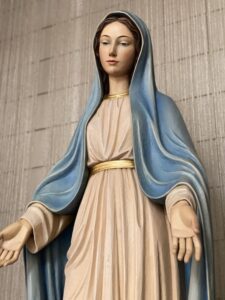
The committee “…received a 12” statue from Italy through Brechting Church Supply so we could see the quality, coloring, wood etc. that the Italian company, Conrad Moroder, makes. A Motion was made…to order the Mary Statue, Our Lady of Grace, in a 5’ size, full round and to submit relevant material samples and colors so to coordinate with our worship space. Also for the statue to have gold at the waist and the neckline… It takes 4-6 months to complete and be delivered. The cost of this particular statue is $8,450 plus approximately $300 for shipping. It would come directly from Italy. The statue would be 5 feet tall, lindenwood, with soft color tones for this price.
Correspondence from Michigan Church Supply– ‘Regarding the painting of our Lady, we ask that the architect of the church send to us a small piece of the glass of the stained window, so we can match the color of the Madonna as much as possible. There is no final color “blue.” The painter mixes it every time new, so it would be much easier to have the piece of glass here.’ It was also agreed upon that they should send a sample of the cream-white color that they would like for her dress to send too.”
To the Art and Environment Committee’s delight, the statue arrived in time for the new church’s dedication on May 22, 1994.
Excerpts taken from the Art & Environment Committee’s Meeting Minutes 1992-1994.
January 20, 2022 – St. Agnes Parish
“We cannot begin the story of Holy Spirit without first acknowledging its beginning as St. Agnes Parish. The year was 1950 and the Diocese was taking into account the population growth on the Northwest side of Grand Rapids, the “outskirts of town” at that time. Land was available on Wilson Avenue between Lake Michigan Drive and Leonard. The possibility of forming a new parish was put into motion.
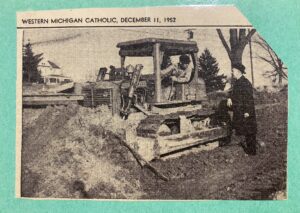 The new parish would be named St. Agnes and Father Bernard Sikorski was named as Administrator in charge of establishing this new congregation. Bill and Gertrude Burke, owners of Rosedale Cemetery, offered their chapel for services and on July 9, 1950, the first Masses were celebrated. About 125 people attended Mass that morning, making it evident that a parish was needed on this side of town… After almost a year and a half search, property on Lake Michigan Drive became available. On January 10, 1952, the diocese purchased 9 ½ acres from Mr. & Mrs. Joseph Czarnopys. The site offered a more central location in a rapidly growing area. With the change of location came a change in name. Since no parish in the diocese was dedicated to the Holy Spirit, on January 15, 1952, Bishop Francis Haas declared that this new congregation would be known as the Parish of the Holy Spirit.
The new parish would be named St. Agnes and Father Bernard Sikorski was named as Administrator in charge of establishing this new congregation. Bill and Gertrude Burke, owners of Rosedale Cemetery, offered their chapel for services and on July 9, 1950, the first Masses were celebrated. About 125 people attended Mass that morning, making it evident that a parish was needed on this side of town… After almost a year and a half search, property on Lake Michigan Drive became available. On January 10, 1952, the diocese purchased 9 ½ acres from Mr. & Mrs. Joseph Czarnopys. The site offered a more central location in a rapidly growing area. With the change of location came a change in name. Since no parish in the diocese was dedicated to the Holy Spirit, on January 15, 1952, Bishop Francis Haas declared that this new congregation would be known as the Parish of the Holy Spirit.
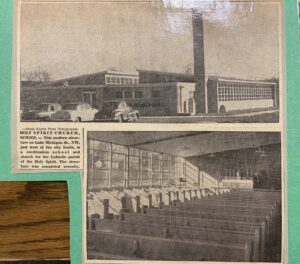
Father Ben began his work by making house calls in much of the area where the church would be built to see if there was any interest in a new church and if there would be financial support. He surprised many a housewife with a personal call. Telephone lines were buzzing with, “you’ll never guess who was here.” and “he’s coming to your house next.” The enthusiasm and support was evident, but there was still the question of money. A building fund drive began, and as you will note, it was just the first of many…
Father Ben engaged Roger Allen & Associates to develop a simple design: a one story building of which half would be for classrooms and half for worship. Then when a more permanent church could be built, the school would expand to the other half. Dan Gietzen and Kenneth Kuhn were asked to serve as chairmen…
Ground Breaking took place on January 18, 1953 much to the delight of parishioners who had been raising funds since May with dinners, card parties, raffles and bake sales… Evenings, men would come to work on the church grounds and help with the assembly and installation of desks so that the school would be ready for the fall semester. Much of the church area finishing work was done under the watchful eye of Joseph Potchen who brought his experience in hand carving to the religious symbols of the altar and communion rail.”
